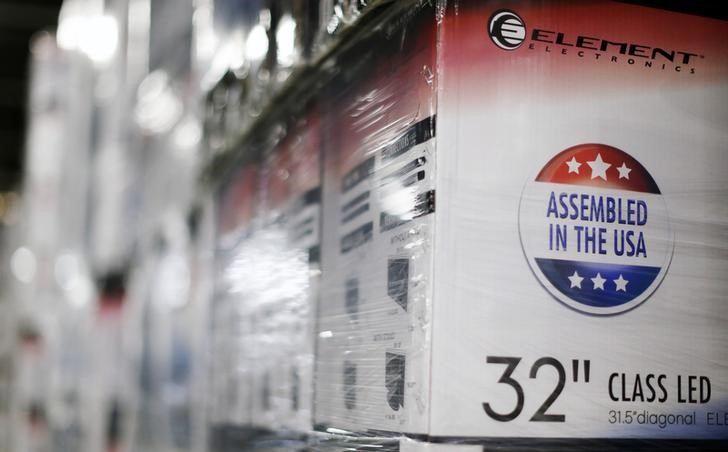By Lucia Mutikani
WASHINGTON (Reuters) - New orders for key U.S.-made capital goods fell in August after four straight months of strong gains and the goods trade deficit widened sharply, prompting some economists to significantly lower their economic growth estimates for the third quarter.
Still, growth projections for the quarter remained at lofty levels, with other data on Thursday showing increased investment in wholesale and retail inventories last month. The Federal Reserve raised interest rates on Wednesday for the third time this year, and Chairman Jerome Powell told reporters that this was "a particularly bright moment" for the economy.
"Third-quarter GDP growth is less boomy, more noisy," said Michael Feroli, an economist at JPMorgan (NYSE:JPM) in New York.
The Commerce Department said orders for non-defense capital goods excluding aircraft, a closely watched proxy for business spending plans, dropped 0.5 percent last month as demand for computers and electronic products as well as motor vehicles ebbed.
The so-called core capital goods orders rose 1.5 percent in July. Economists polled by Reuters had forecast orders for these goods rising 0.4 percent last month. Core capital goods orders increased 7.4 percent on a year-on-year basis.
Shipments of core capital goods edged up 0.1 percent last month after jumping 1.1 percent in July. Core capital goods shipments are used to calculate equipment spending in the government's gross domestic product measurement.
With business confidence at multi-year highs, in part buoyed by a $1.5 trillion tax cut package, August's surprise drop in core capital goods orders is likely to be temporary. But economists worry an escalating trade war between the United States and China could hurt confidence and undercut spending.
Washington on Monday slapped tariffs on $200 billion worth of Chinese goods, with Beijing retaliating with duties on $60 billion worth of U.S. products. The United States and China had already imposed tariffs on $50 billion worth of each other's goods.
While manufacturers have expressed concerns about the tariffs, which are contributing to bottlenecks in the supply chain, there are so far no indications from economic data that the trade tensions are having a big impact on the economy.
"The big wild card for business investment is how the trade tariffs and persistent policy uncertainty affect capital expenditures," said Kathy Bostjancic, head of U.S. Macro Investor Services at Oxford Economics in New York.
The dollar firmed against a basket of currencies. Stocks on Wall Street were trading higher and U.S. Treasury yields rose slightly.
EXPORTS DECLINE
The Commerce Department confirmed in a second report on Thursday that the economy grew at a 4.2 percent annualized rate in the second quarter. That was the fastest in nearly four years and almost double the 2.2 percent pace set in the first quarter.
A third report from the Commerce Department showed the goods trade deficit rose $3.8 billion to $75.8 billion in August.
Exports of goods fell 1.6 percent to $137.9 billion, weighed down by a 9.5 percent plunge in shipments of food, feeds and beverages. That likely reflected a continued reversal of soybean exports after farmers front-loaded shipments of the crop in April and May to China before Beijing's retaliatory tariffs came into effect in early July.
Exports of industrial supplies and motor vehicles also declined last month. There was, however, a surge in exports of consumer and other goods. Imports of goods increased 0.7 percent to $213.7 billion in August, driven by motor vehicles, consumer and other goods.
Economists said importers were likely stockpiling goods before the U.S. duties on Chinese imports became effective.
A smaller trade deficit added 1.2 percentage point to GDP growth in the second quarter, but a reversal is expected in the July-September period.
The expected drag could, however, be partly offset by increased investment in inventories. Wholesale inventories jumped 0.8 percent in August and stocks at retailers rose 0.7 percent, the Commerce Department reported.
Taking Thursday data into account, JPMorgan lowered its third-quarter GDP growth estimate by five-tenths of a percentage point to a 3.0 percent rate. The Atlanta Fed slashed its forecast to a 3.8 percent rate from a 4.4 percent pace.
The outlook for the economy remains upbeat amid a robust labor market. In a fourth report on Thursday, the Labor Department said initial claims for state unemployment benefits rose 12,000 to a seasonally adjusted level of 214,000 last week.

That was likely as Hurricane Florence temporarily displaced some workers. Claims fell to 202,000 during the week ended Sept. 15, which was the lowest level since November 1969.
